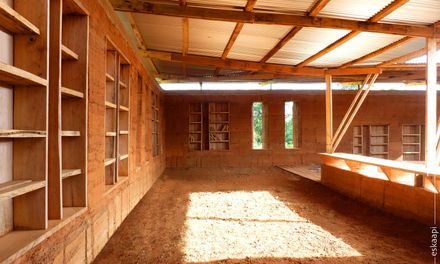Framed Escape Library
ARCHITECTS
Eskaapi
ARCHITECTS IN CHARGE
Maude Cannat, Rachel Méau
LOCAL WORKERS (GHANA)
Anor, Mark, Edward, Samy, Collins Junior, Collins Senior, Ebenezer, Opoku, Abass, Kofi, Amelia, Zinabu, Afifa, Ernest, Sebe
WORKSHOP PARTICIPANTS
Akim Pavageau, Lucas Corcuera, Ana Elisa Cordeiro Alves, Sarah Fabry, Sofia Giber, Carolina Margarita Omonte Salazar, Fabiola Cruz B, Jessica Quevedo, Samanta Sinistri, Valentin Grasset, Olivier Bleriot, Julie Bujon, Remy Rodrigue, Bastien Limouzin-Michault, Evolène Bonnard, Tess Bourgenot, Juline Rallet, Pierre Alies, Flavian Yvon, Veronika Kudryashova, Paulette Alvia, Marli Swanepoel, Paul Jordaan, Mathieu Roche, Tim Kölle, Alexandre Bourdon, Hamza El Houari, Milena Stagni, Phylippe Méau, Camille Esteve, Yeonwoo Shin, Louis Cannat
PHOTOGRAPHS
Maude Cannat, Rachel Méau, Steve Santos
AREA
164.0 m2
YEAR
2017
LOCATION
Abetenim, Ghana
CATEGORY
Schools
Text description provided by architect.
A new school is being built at the entrance of Abetenim’s village, in Ghana’s Ashanti Region.
Its library, built with local materials such as earth and wood, was designed by French architects Maude Cannat and Rachel Méau, first prize winners of the 2016 Earth Architecture Competition.
With only a 9000-euros fund-raised budget and no electricity on site, innovation and creativity were employed to conserve resources and build cleverly; using environmentally friendly architecture, water-efficient construction, often repurposed local materials, and precious savoir-faire trading.
Thick, rammed earth walls pierced with tall, narrow windows insulate the library from the outside without revealing what is hidden inside.
As you enter, you discover in a light and cool atmosphere two spaces connected around a landscaped patio, waiting to be used by the school children.
The first one, on the same level as the entrance, is ideal for studying and research.
The second one, in a hollow space sculpted by terraced steps, invites the visitor to sit for a reading session.
The library and its furniture form one whole entity: the wooden bookshelves are directly integrated in the walls, the flared window embrasures can also serve as seating, and a long working table runs along the patio wall.
The detached roofing and vertical windows provide ventilation, while the earthen wall structure ensures that coolness circulates through the entire building.
Everything was carefully planned to conserve resources. Thus, the earth extracted for the foundation was compacted with metal panels in the walls, the wood forms were reused for the flooring, and salvage materials were used for the doors and all the wood finishing touches of the library.
The architects in charge of the organization eskaapi gathered a team of thirty international volunteers and a dozen local workers to work together during a four-month period.
The library’s construction was the first workshop led in the village to support the future school. Since then, three more classrooms were built by three different international teams next to eskaapi’s building.






















